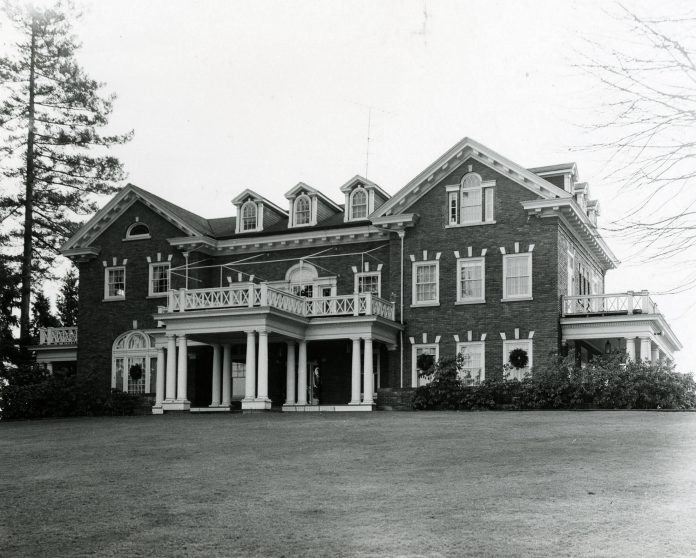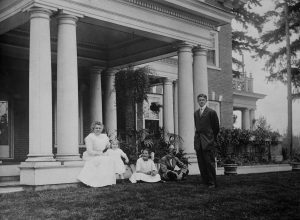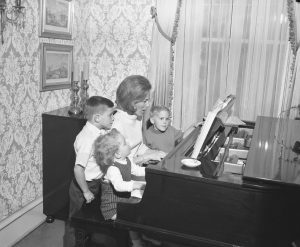
Nestled on a bluff overlooking Budd Inlet and the Olympic Mountains, the elegant Governor’s Mansion in Olympia is a bustling hive of activity. While the house is home to the governor and their family, including their pets, the mansion is also a public place belonging to the people of Washington State. Many people have visited the house from princes and presidents to thousands of ordinary people.
 Before the current governor’s mansion was built, governors and their families had no official residence. Isaac Stevens, the first territorial governor, built a house near land donated by Olympia founder Edmund Sylvester for the capitol. Other officials later lived in the house, including Territorial Governor Elisha Ferry, but most governors rented houses in town.
Before the current governor’s mansion was built, governors and their families had no official residence. Isaac Stevens, the first territorial governor, built a house near land donated by Olympia founder Edmund Sylvester for the capitol. Other officials later lived in the house, including Territorial Governor Elisha Ferry, but most governors rented houses in town.
Washington became a state in 1889, beginning a period of change. Construction on a new state capitol, designed by Ernest Flagg yards away from the future governor mansion site, stalled due to an economic depression. The government ended up moving into the former Thurston County courthouse in downtown Olympia and making it the capitol building.
But the governor remained without an official residence. This changed when the Alaska-Yukon-Pacific Exposition was being planned for Seattle. The international fair would attract dignitaries and other important guests from around the nation, and the world, and the state wanted a fitting place to entertain them when they visited the capital city. Their solution? Build a governor’s mansion where visitors could be suitably hosted.
But at the same time the state was considering building a new capitol building on the site of the unfinished Flagg foundations. So, they decided to spend $35,000 to construct a temporary mansion. The house, consisting of 19 rooms, was built in the Georgian style, picked to match the time period of President George Washington, for whom the state is named.

Tacoma architects Russell and Babcock were hired to design the building. The cornerstone was laid with a Masonic ceremony on August 1, 1908 on the mansion’s northwest corner.
Albert Mead, governor at the time, however, would not see the building completed, losing reelection to Samuel Cosgrove. The house was finished in January 1909, but Cosgrove was too ill to attend an official house warming party the day after his inauguration. The famed “governor for a day” instead went to California to recuperate where he died a few months later.
Lieutenant governor Marion Hay was immediately sworn in as governor. Hay, his wife Lizzie and their large family were the first family to live in the mansion. Their sixth child, Margaret was even born in the house.
The mansion was not really ready when the Hays moved in and local Olympia women lent the family furnishings. The legislature soon appropriated $15,000 to furnish the house. Lizzie Hays bought all carpets and furniture from Frederick & Nelson in Seattle. Some of these furnishings, including a Grandfather clock, dining room table (with 20 chairs) and matching buffet are still used today.
While he did have a garage added to the house in 1913, incoming Governor Ernest Lister was not impressed by the new building’s plumbing and electrical issues and sagging floors. The building’s poor insulation and tall ceilings left it so cold that Lister moved his family to a local hotel in the winter of 1915. The house, he famously said was, “a monument to the high cost of low bids.”

While the house did not change all that much over the coming decades, the campus was quickly growing up around it. First came the Temple of Justice in 1913, the Insurance Building in 1921 and finally the Legislative Building/Capitol in 1928. It took many years to finish the Capitol building. Governor Hart’s granddaughter Frances Torpey Shumway visited the mansion many times as a child and remembered the construction as exciting. “The lights were on all night long,” she later recalled. “It was very, very noisy and it looked like a great big hole.”
Despite being designed as temporary—the famous Olmstead landscaping plan shows a future building in the mansion’s location—the Governor’s Mansion was not torn down. The building suffered serious damage during the1949 earthquake.
By the 1960s, however, the legislature was considering demolishing the aging building and replacing it with a modern house. First Lady Nancy Evans, wife of governor Dan Evans, and others were outraged and fought to save the historic house. They founded the Foundation for the Preservation of the Governor’s Mansion, an all-volunteer, non-partisan and non-profit organization in 1972. The group changed its name to the Governor’s Mansion Foundation in 1988.

After years of lobbying, the legislature agreed to renovate and remodel the governor’s mansion in 1973, estimating costs at two million dollars. The construction project took several years. The Governor’s Mansion Foundation helped collect privately donated furniture from the Georgian period, to match the time period of the house’s style. This furniture decorates the public and some of the private rooms.
Today, the Governor’s Mansion is the oldest surviving building on the capitol campus. It has seen the campus grow and change over the decades. The historic home is open for guided public tours by the Governor’s Mansion Foundation. The Foundation continues to help preserve and interpret this state landmark in the Capital City.



















































